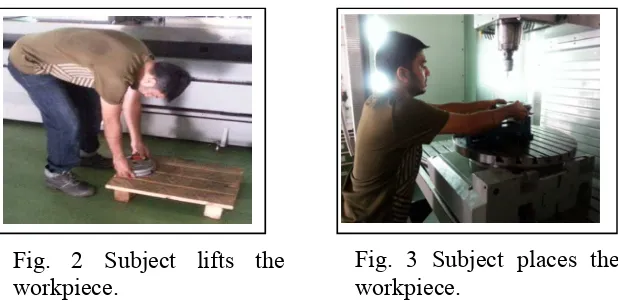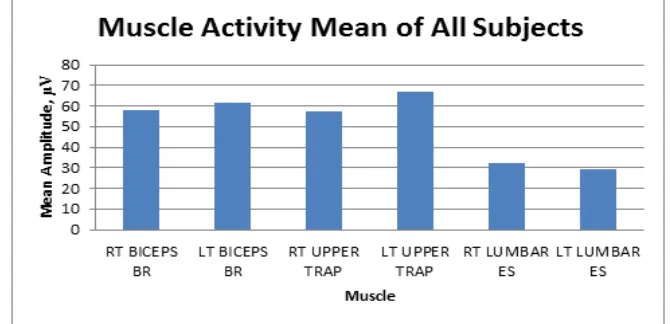The Effects of Roller Conveyor on Muscle Activity in Workpiece Loading
on CNC Machining Centre: A Preliminary Study
Hafiz Zani M.
a, Isa Halim
b, Muhammad Syafiq S.M.
c, Rawaida O.
d,
Nuradilah Z.
eand Fatihah Ros A.
fFaculty of Manufacturing Engineering, Universiti Teknikal Malaysia Melaka, Hang Tuah Jaya, 76100 Durian Tunggal, Melaka, Malaysia
a[email protected], b[email protected], c[email protected], d[email protected],
e[email protected], f[email protected]
Keywords: CNC machining centre, Work piece loading, Muscle activity, Surface electromyography
Abstract. In the recent years, Advance Manufacturing Technology (AMT) has been widely used in manufacturing industry to increase manufacturing process capability. However, Computer Numerical Control (CNC) machine designs have only focused on its operational capability. The harmonious coordination between users and CNC machines is often neglected, which can contribute to hazardous working practices that can affect the health of users. Bending posture while loading the work piece to the machine can cause fatigue and discomfort to the users. Thus, the focus of this preliminary study is to analyse the effect of CNC machine work piece loading on muscle activity levels and to determine the effectiveness of roller conveyor in reducing muscle activity levels. Muscle activity has been analysed using surface electromyography (sEMG) technique. Erector spinae, biceps and trapezius muscles were concurrently measured during the work piece loading. Five male subjects (n=5) participated in the pre-intervention study and two subjects (n=2) in the post-intervention study (roller conveyor implementation) participated to test the effectiveness of the roller conveyor. Result pre-intervention study found that muscle activity level of biceps was the highest followed by trapezius and erector spinae. Based on the post-intervention study involving the roller conveyor, muscle activity of the erector spinae was reduced meanwhile the muscle activity of biceps and trapezius increased for both subjects.
Introduction
Improper machine tools design contributes significantly to the development and chronicity of occupational injuries. Any machine tool design must consider the workers’ anthropometry and limitations. The CNC machining centre is not excluded from this requirement. The CNC machining centre is one of machine tools used in manufacturing industry. It is used to machine solid materials like steel. However, the design of CNC machine only focus on its functional but ignoring the coordination between man and machine[1,2]. The design of CNC machining centre has a significant influence in the development of occupational injuries and discomfort [3]. Previous study pointed that by improving the ergonomics criteria of tools, the health and job satisfaction of workers might be positively affected [3,4]. The common problem arises due to improper design of machine tools is the workers are required to perform the task in an awkward working posture. Bending, twisting and reaching the materials in an inappropriate level are several examples of awkward working posture [5,6]. Awkward working postures may lead to occupational injuries such as lower back pain, and as a consequence, it will reduce company’s productivity [6]. Besides, improper machine tools design are the main causes for the joint pains, nerve entrapment problems, sprains and strains, and sometimes chronic and acute injuries in the body parts such as hands, wrists, arms, neck and back [7,8]. These problems minimize capabilities and capacities of the workers and thus negatively affect their health as well as productivity. Workers’ compensation losses associated with manual materials handling is one of the most significant loss sources in many industry sectors. Worldwide data shown that the main contributor to occupational injuries and accident, loss of productivity and compensation costs are mostly related to manual materials handling activities in the industry [9,10].
The surface electromyography (sEMG) can be used to measure muscle activity of workers while performing manual materials handling jobs. The sEMG has been recognized as a tool to measure the electric signals corresponding to muscle contractions [11,12]. The aim of this study is to analyze the effectiveness of roller conveyor in assisting users for work piece loading to CNC machining centre. A pre-post study using sEMG was conducted to determine the effects of the roller conveyor on muscle activity.
Method
This study was divided into two phases, pre and post interventions. In the pre-intervention phase, five healthy subjects with no history of musculoskeletal problems were selected from the male students at the Universiti Teknikal Malaysia Melaka. The subjects were given experimental procedures so that they understand the steps and protocols in the experimental work. A full factorial design consisting of 8 (23) experiments was developed and each test replicated five times to test the
muscle activity of subjects performing the work piece loading task. The experiments took about four to five hours to be completed. Factors considered were load repetitions (8 and 20 times), load mass (3 kg and 10 kg) and body angle (normal and maximum reach) while loading the work piece on a CNC machining centre. A randomization set of experiments was performed using Minitab, version 16 software in order to reduce opportunity for bias and confounding in experimental design. Two minutes of time interval for every replication were given to the subjects for the purpose of muscle fatigue avoidance [13]. They were given sufficient time to get familiar with the experimental procedures before the actual data collection began. The demographic details of the subjects are tabulated in Table 1.
Table 1 Demographics of the subjects.
Criteria Min Mean Max Standard Deviation
Age 22 25.5 29 4.95
Body mass (kg) 63 74 85 15.56
Body height (cm) 165 170.5 176 7.78
After completing the pre-intervention study, a roller conveyor was used in the post intervention phase to load the work piece manually to the CNC machining centre. The work piece is placed on a table lifter. Fig. 4 and 5 show the implementation of a roller conveyor that attached to the machine. Two subjects managed to undergo the experiment using the conveyor implemented to measure the muscle activity levels.
Results
Fig. 6 and 7 show the mean of amplitude (µV) of the muscles measured from all subjects when performing the work piece loading on CNC machining centre during the pre-intervention phase. The y-axis shows the mean of amplitude (µV), meanwhile x-axis indicates the muscle measured. The mean of amplitude (µV) for all muscles fluctuated throughout all the subjects, corresponding to subjects’ muscle activity changed when performing the task. Based on Fig. 6, the left upper trapezius indicated the highest muscle activity level (67.18 µV) followed by the left biceps (61.76 µV). Meanwhile the muscle activity level of the left and right erector spinae was the lowest among the other muscles, 32.51 µV and 29.50 µV respectively.
Fig. 7 and 8 show the comparison of muscle activities between the two subjects at pre and post intervention phases. The muscle activity of right and left trapezius of subject 1 increased when loading the work piece using the roller conveyor. Meanwhile, the muscle activity of left trapezius and left biceps of subject 2 increased. This is due to, when using the roller conveyor to load the work piece, the subjects need to push the work piece as close as possible to the machine table. Meanwhile, the muscle activity of the erector spinae decreased as a result of natural body posture when pushing the work piece.
Fig. 4 Roller conveyor attached to the CNC
machining centre Fig. 5 Subject uses roller conveyor to push work piece to machine
Discussion
Based on the result, this study found that the application of the roller conveyor has increased the muscle activity levels in the biceps and trapezius muscles, as shown in Fig. 7 and Fig. 8.However, this study observed that there is an advantage of using the roller conveyor. The muscle activity of erector spinae decreased due to elimination of bending posture. Based on these findings, the roller conveyor may not a best solution to reduce muscle activity in work piece loading of CNC machining centre.
Conclusion
Muscle activity levels can be minimized through application of engineering and administrative controls. However, this study concluded that application of roller conveyor in work piece loading on CNC machining centre causes the muscle activity of biceps and upper trapezius increased.
Acknowledgment
The authors would like to acknowledge the Ministry of Education Malaysia for funding this research under Research Grant (project no.: RAGS/2012/FKP/TK01/2 B0013), the Faculty of Manufacturing Engineering of Universiti Teknikal Malaysia Melaka (UTeM) for providing facilities and assistance to prepare this paper.
References
[1] C. Yang, The study of CNC machine tools interface design, Appl. Ergon. 109 (2013) 95-698.
[2] P. Seppala, E. Touminen, Job characteristics and mental and physical experienced, Int. J. Ind. Ergon. 9 (1992) 25-35.
[3] Information on http://www.intechopen.com/books/ human-machine-interaction
[4] B. Das, A.K. Sengupta, Industrial workstation design: A systematic ergonomics approach, Appl. Ergon. 27 (1996) 157-163.
[5] J.R. Wilson, Participation – a framework and a foundation for ergonomics, J. Occup. Organ. Psych. 64 (2001) 67-80.
[6] A.M. Macias, M.G. Ramirez, J.L. Garcia, J.J. Diaz, S. Noriega, “Ergonomics Evaluation of Work Stations related with the Operation of Advanced Manufacturing Technology Equipement: Two Case of Study”, XV Congreso Internacional De Ergonomica, pp.1-7, Jun 2009.
Fig. 8 Mean amplitude of muscle measured before and after implementation of roller conveyor (subject 2).
[7] E.R. Vieira, S.O. Kumar, Occupational risks factors identified and interventions suggested by welders and computer numeric control workers to control low back disorders in two steel companies, Int. J. Ind. Ergonom. 37 (2007) 553-561.
[8] A.S. Asraf and M.S. Naseem, Ergonomics, and occupational health and safety in the oil industry: A manager’s response, Ind. Eng. 47 (2012) 223-232.
[9] Information on http://www.intechopen.com/books/ergonomics
[10] S.M. Alavinia, D. Molenaar, A. Burdorf, Productivity loss in the workforce: Association with health, work demands, and individual characteristics, Am. J. Ind. Med. (2008) 1-8.
[11] I. Hostens, H. Ramon, Assessment of muscle fatigue in low level monotonous task performance during car driving, J. Electromyogr. Kine. 15 (2005) 266-274.
[12] A. Luttmann, M. Jager, W. Laurig, Electromyographical indication of muscular fatigue in occupational field study, Int. J. Ind. Ergonom. 25 (2000) 645-660.
[13] R. Escorpizo, Understanding work productivity and its application to work-related musculoskeletal disorders, Int. J. Ind. Ergonom. 38 (2008) 291-297.
[14] K. Muthukumar, K. Sankaranarayanasamy, A.K. Ganguli, Discomfort analysis in computerized numeric control machine operations, Int. J. Ind. Ergonom. 3 (2012) 146-153.


